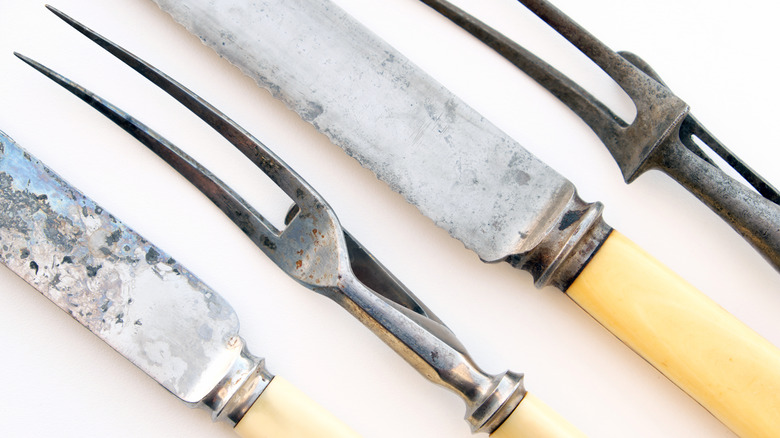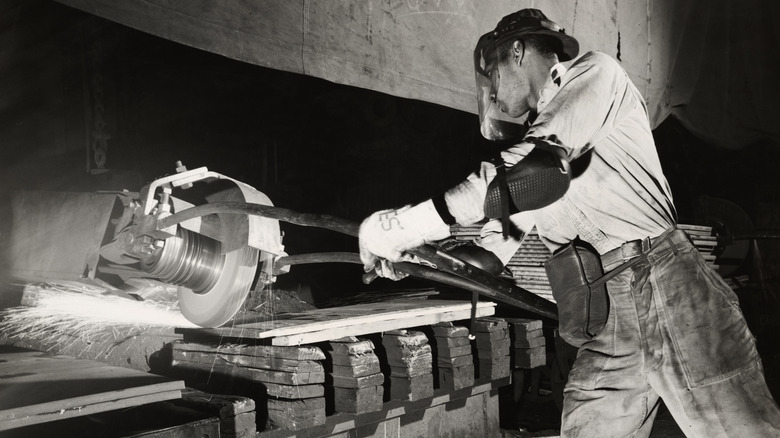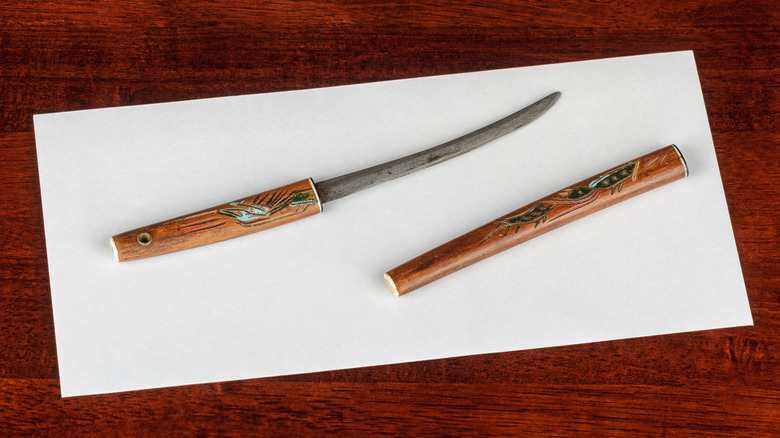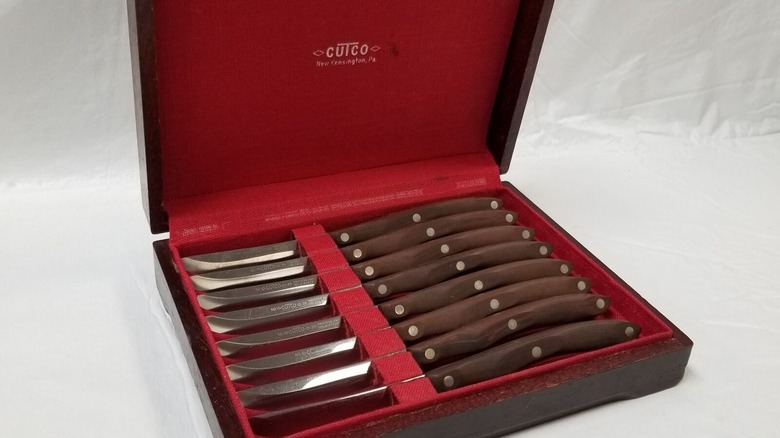The Surprising History Of The Steak Knife
The next time you use a steak knife to cut into a nice juicy steak, you'll appreciate it a little more knowing its history. Steak knives haven't been around as long as you probably think they have. Their idea was delayed for a few centuries by men in high places who didn't like pointy knives. Even without the world having to bend to these men's pet peeves, several inventions of the 1900s were necessary to make them even possible.
Once the idea of them emerged into the world, they were an overnight success. Old knife-making skills continued to combine with new inventions to make them even better as the decades progressed. So, that dusty set of Cutco or Ginsu in your attic from yesteryear has many modern, superior rivals. We think you'll be surprised about how steak knives began and how they evolved. So, sit back and discover their history with us. Chances are, you'll end up wanting a set next time you make the perfect steak at home.
Knives had some problems before the invention of steak knives
Steak knives had to overcome some problems before they could emerge as they are today. It has taken unnumbered generations and advances in technology to perfect knives as we know them. Even after people started using metal for knives rather than stone, there were all sorts of problems.
Early metal knives were quick to corrode, rust, stain, and dull. Plus, they required a lot of upkeep. If you didn't work to keep them clean and sharp or have servants to do it for you, you were left sawing into your food with lots of effort, leaving rust and other knife gunk behind on your meat. While some people eventually had specialized knives for the dinner table, plenty used the same sharp-tipped knife they carried around all day to cut their meat, which left the metal even more stained and dulled. If you take a look at table knives from even as recently as the 1800s, they don't look like they'd be good for cutting steak without quite a lot of effort.
The steak knife's invention was impeded by bad table manners
Something close to today's steak knife might have been invented earlier if it weren't for Cardinal Richelieu in the 1600s. This powerful French cardinal of the Catholic Church despised watching people picking food out of their teeth with the sharp ends of their knives at the dinner table. This pet peeve led to the invention of a table knife far from our modern version with a rounded end that couldn't work as a toothpick. Imagine trying to get something out of your teeth with a butter knife, and you'll understand his solution.
Even though Richelieu had been King Louis XIII's chief minister, it was King Louis XIV who liked the idea of the rounded knife enough to make sharp-pointed ones illegal in France. Starting in 1669 (27 years after Richelieu's death), not only could you not have a pointed knife at the table in France, but you couldn't walk around on the street with a knife sharp enough to easily stab people (or kings) either. So, not only were you less likely to stab someone while walking out and about with a blunt-tipped knife, but the chance of a casual dinnertime stabbing also grew smaller. Despite not being under French rule, knives became blunt-ended throughout Europe after the king's decree. Even the ones imported from Europe to the U.S. were blunt. However, by the 1800s, table knives were finally starting to get their sharp tips back.
The invention of stainless steel helped make modern steak knives possible
Harry Brearley invented stainless steel in 1913 while perfecting corrosion-prone British gun barrels. It changed knives forever. After the war, stainless steel was suddenly everywhere. Between 1919 and 1923, cutlery was among the first uses for this metal. Stainless steel solved a lot of the problems that early knives had. It's durable and stays shiny rust- and corrosion-free without needing labor-intensive polishing. However, early stainless steel still needed some work before it became what it is today.
While it was invented the year before World War I began, patents for improvements didn't start rolling in until the year after the war ended. In the earlier days of stainless steel before World War II, knife blades still dulled quickly. The more you used them the duller they became, and the more you sharpened them, the more they lost their luster.
Modern steak knives have only been around since after World War II
While steak knives are ubiquitous kitchen utensils these days, they didn't exist until after World War II. Even though sharp-tipped knives were back in vogue again and stainless steel had been around for a while, steak knives just hadn't been dreamed up yet, and everything wasn't in place yet for their invention.
Stainless steel still needed some improvements. While steel was in its infancy, early stainless steel knives needed regular sharpening as they dulled with usage. However, in the 1950s after World War II, metallurgists discovered that they could treat stainless steel with heat in a way that would help keep knife blades sharp longer. So, it wasn't until after World War II that modern steak knives were even possible. Even the factory of the company that would eventually make the first steak knives wasn't ready yet. During World War II, the Briddell Company was busy making bazooka shells and machetes for troops, supporting war efforts above all else, like so many factories of the time.
The idea for the steak knife started with a letter opener
Not everyone sees the same object the same way, which is what happened to bring about the invention of the steak knife. Interestingly enough, the steak knife began life as a letter opener. Before World War II hit, Briddell Company in Crisfield, Maryland, was mainly manufacturing items like oyster knives, oyster tongs, and ice tongs. A machinist named Paul Culver designed machete handles for the company in his spare time during the war and was also a good friend of one of the owners of Briddel Company, Charles Briddell, Jr.
Away from work, Culver spent his free time piddling around his barn-turned-shop, doing woodworking, and making things like specialty knives. He made a fancy letter opener set while working as a machinist for Martin & Schwartz and gifted it to Briddell for Christmas in 1946. When Charles Briddell's brother Tom saw the beautifully designed letter openers on his brother's desk, he imagined them becoming steak knives. Tom immediately asked Culver to make a prototype knife set with an ivory plastic chest, and soon ended up putting him on the company payroll making steak knives and other cutlery items for the company.
Carvel Hall was the first steak knife brand
The Briddell Company produced its first steak knives under the Carvel Hall brand name. The knives' brand name came from the stately Carvel Hall Hotel in Annapolis, Maryland, which was also a former home for Declaration of Independence signer William Paca.
We found an advertisement for a Carvel Hall Steak Knife Set in The News Journal from 1948. The knife set cost $16.50. Adjusted for inflation, it would be valued at about $216 today. So, buying one was an investment. The ad boasted, "The new Carvel Hall, worthy companion to the finest table silver, is a knife of sheer utility. Slimly graceful though it is, its long, tapering blade of finest steel cuts through the thickest steak with ease. Every home needs this smart steak knife set."
After the company became known for its Carvel Hall line of steak knives, it made sense to change the business name from Briddell Company to Carvel Hall. The company changed owners a few times over the years before closing down completely in 2000. So, if you want to buy a gorgeous set of Carvel Hall knives today, you'll have to buy them second-hand.
Steak knives became the dream invention for door-to-door salesmen
Once Briddell Company unleashed its steak knives upon the world, they became an overnight sensation. It took only a month for the company to sell $1 million in steak knives. That amount would be over $13.1 million today. Other companies latched onto the idea as well. Surprisingly enough (from our modern standpoint), families were happy to open their doors to knife-bearing strangers back then.
In 1949, slightly later than Carvel Hall was selling its steak knives, another knife brand you've likely heard of called Cutco was being pedaled door-to-door. By the 1970s, Ginsu knife infomercials were convincing people that they must have a set of miraculously superior steak knives (and more!) for their kitchens. These companies certainly weren't the only ones, but they're the ones with the marketing ploys we remember best.
Door-to-door knife salesmen would wow their customers with features like ergonomic handles, patented blades, and free sharpening for life. To a family accustomed to having to hack at their food with dull, subpar knives, all of these cutting-technology steak knives that could cut through steak like soft butter were wildly appealing. Plus, they'd demonstrate how well the knives could cut compared to the knives potential customers had in their kitchens. When your ordinary kitchen knives tore bread, smashed tomatoes, and couldn't cut through thick rope and leather, you'd be convinced you needed a set of fancy steak knives (and maybe some other knives, as well).
The Wedge-Lock Handle made these knives more ergonomic
Thomas Lamb was obsessed with hands and spent part of his career creating illustrations of hands for surgeons. After so much time devoted to studying the intricacies of hands, he created an ergonomic handle called the "hand perfect handle" and later the "Lamb Wedge-Lock Handle." These handles were designed in 1941 and patented in 1945, so they pre-dated steak knives. It's one more invention that eventually made them better.
Lamb described his handle by saying, "It wedges the fingers apart and locks the thumb and fingers on place" (via MoMA). Even though these handles went on to make holding and carrying a wide variety of items easier, the first place they became popular was on kitchen tools. Their clever design made them perfect for left- or right-hand use. On a knife, it made the cutting process less likely to hurt your hands, and the knife less likely to slip out of your grip. Cutco is one of the many brands that jumped on Wedge-Lock Handles in 1952 to make the knives better. However, it wasn't the only one.
Not all steak knives have traditionally been serrated
Even though many of us have serrated steak knives in our kitchens, the original Carvel Hall steak knives weren't serrated. Which style is best is a matter of debate, so the one you choose to own is up to you based on what you want from steak knives and how often you want to sharpen them.
Some people prefer serrated knives since they can saw through meat and stay sharp longer than non-serrated knives. However, they usually require a professional to sharpen them. So, as they dull over time, the average owner tends to make do with an ever-duller steak knife. Straight-edge steak knives without serrated edges provide a cleaner, prettier cut of steak rather than a jagged one, and more juices tend to stay in the meat instead of pooling on the plate. You have to do a lot of sharpening since their razor-sharp edges dull easily from coming in contact with your plate every time you slice a piece of steak.
Slotted knife blocks for steak knife storage weren't prevalent until the 1970s
The first steak knives came in a fancy box, which enhanced their presentation and made them ready to give as a gift. They were easy to put in a drawer or on a shelf until you needed to use them. However, in the 1970s, the trend became to make them more accessible by placing them in a wooden slotted knife block on your countertop. A 1975 advertisement in the Los Angeles Times for a steak knife block by Chicago Cutlery tried to entice customers by saying, "Knives that have the quality of steel but can maintain a sharp edge are prized by most cooks. And when they can be handsomely and conveniently displayed, they take on even more importance."
Over the years, there have been various improvements to the knife block idea, with inventors making them lockable, tiltable, and even ergonomic. Some even have built-in knife sharpeners. There's even a modern unslotted version that can easily receive any knife between thousands of slender rods that help keep the knives sharp.
They have evolved to have a variety of feature options over the years
While buying steak knives sounds fairly straightforward to someone casually buying a set, there are more options than you can imagine. You can pay tens or hundreds of dollars, depending on the brand and features. You have various metal choices. The higher the carbon content, the stronger the knife is. While high-carbon steel is harder and stays sharp longer, it's not rust-resistant like stainless steel. Another option is a ceramic blade, which stays sharp for a while but can break or chip easily. Then there's Damascus steel, whose beautiful designs come from hammering steel layers together. Higher-quality blades are created through forging rather than stamping, but they're also more expensive. As mentioned, serrated knives stay sharp longer, but they're difficult to sharpen and don't cut as precisely. You might also notice whether it's a single-bevel blade, which limits you to cutting with just one hand (left or right), or a double-bevel, which has two cutting sides.
The handle also matters. Knife blades are less likely to break off the handle if they have a full tang, which means that a portion of the blade extends into the handle rather than being attached to the top of the handle. When it comes to handles, they vary between wooden, synthetic, rubber, and metal, which can affect grip and whether or not you can put them in the dishwasher or need to provide them with extra upkeep.
German steak knives are developed to be more durable
German steak knives have a reputation for being sturdy and robust. They're utilitarian steak knives that get right down to the business of cutting steak the right way. When you pick up a German steak knife, you'll find that it has a heavy, thick blade with a full-tang handle that helps prevent the blade from breaking.
The blades are forged from a single piece of steel and often include pins to keep them firmly affixed to the handle if the handle isn't forged with the knife. The metal in the blades comes from a variety of steel alloys. They're sharp but tend to be on the softer side, ranging from 57 to 59 on the HRC Rockwell scale, which makes them less likely to chip. Hefty German steak knives have more curves than Japanese varieties. The thick metal in the blades tapers down to the edge at an 18- to 20-degree angle. Serrated versions also exist.
Japanese steak knives are developed with more precision blades
Knife-making skills in Japan have been handed down from the art of sword-making. Not only are their steak knife blades distinctive and not usually serrated, but the handles have particular qualities, too. Japanese steak knives use thinner pieces of metal, so they're lightweight rather than hefty. The blades have a balance point to give you more control and keep you from tiring while cutting. Japanese knife makers use a variety of steel alloys to make their steak knives. However, these alloys are often harder than German alloys, falling between 59 and 67 on the HRC Rockwell scale. Harder metal makes sharper blades. Sharper blades would be easier to break if the Japanese hadn't solved this problem by using different types of steel in multiple layers. Having a softer outside and harder inside makes them easier to sharpen while staying sharp longer. Precision sharpness comes from both the metal and shape of the blade. Meanwhile, hammering the layers together creates beautiful Damascus steel patterns.
Japanese steak knives use two different types of handles. Wa (Japanese) handles are made from lightweight natural substances like wood or horn, with the metal of the blade (tang) tapering deep into the handle. Meanwhile, yo (Western) handles are sturdier and heavier handles made from wood, plastic, or bone and have a tang more like German knives. Wa handles require more care than yo handles and are easier to replace.
Steak knives are still a remarkably big business
Even though you won't have anyone coming to your door trying to sell you a set of steak knives these days (thank goodness), steak knives are still a big money-maker. With the cost of food rising, more people are learning to make perfect steaks at home, which has been a boom for the business. According to Research and Markets, consumers bought $1.89 billion worth of steak knives in 2023. By the time 2028 rolls around, it projects sales to increase to $2.75 billion.
Some of the biggest companies in the business are Mede, Kanzen, Messermeister, Corelle, Atelier Perceval, Laguiole, Victorinox, Wüsthof, Zwilling J.A. Henckels, and Steelite. While they all sell other knives, the amount of money these companies make on steak knives alone is fairly significant. For example, Wüsthof makes up to $125 million in a single year just with its steak knives.
While some companies are making sets that cost only $20, plenty of others are charging hundreds or even $1000 per set. Don't judge them by cost alone, though. Steak knife sellers are counting on you to think you're getting superior steak knives just because they cost more, which is not always the case. You'll want to do plenty of research first, looking at the type of steel alloy it uses, and finding out where it's made.














